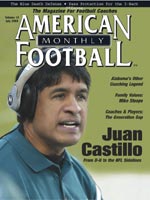Article CategoriesAFM Magazine
|
Rebirth of the \'Blue Death\'Team defense at North Carolina A&T© More from this issue Family. Above all else, the one element that most contributed
to our success as a team and as a defensive unit was a family atmosphere
brought to the program in the Spring of 2003 by our head coach,
George Small. More important than the success experienced on the
football field was the way that kinship maintained us as we endured
the passing of one of our young and most talented players, Herb
Dixon, this past off-season. Together, we are moving forward and
working this spring to build on our 2003 MEAC championship and
NCAA Division I-AA playoff season.
|
|
|||||||
| HOME |
MAGAZINE |
SUBSCRIBE | ONLINE COLUMNISTS | COACHING VIDEOS |
Copyright 2025, AmericanFootballMonthly.com
All Rights Reserved





